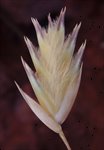
T. brizoides spikelet.
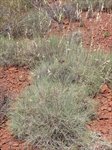
T. brizoides habitat.

T. brizoides orifice and sheath with woolly hairs.
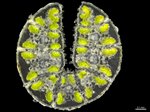
T. brizoides leaf section.

T. brizoides inflorescences.
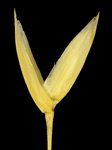
T. brizoides glumes.
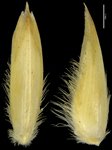
T. briziodes lemmas.
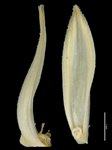
T. brizoides paleas.

T. brizoides map.
Name
Triodia brizoides N.T. Burb.
Citation
J. Roy. Soc. Western Australia 30: 24–25 (1946)
Derivation
brizoides — from the (transliterated) Greek briza, rye, and –oides, resembling, in reference to the similarity of the spikelets to Blowfly Grass, Briza maxima.Common name
Nodding Spinifex
Synonyms
None
Diagnostic features
Foliage non-resinous, usually blue-green when fresh but sometimes dull green; leaf sheath surfaces woolly; orifice woolly; leaf blades amphistomatous (hard-type); longest basal pedicels >4 mm long; lower glume L:W 1.8–2.9, 3–5(–9)-nerved; lemmas shortly to deeply lobed, not awned, uniformly textured; lemma body with long hairs along lower midline and along at least the lower half of margin (sometimes extending to the base of the lobes); palea hairy but sometimes only at extreme base; on rocky ridges or stony outcrops.
Habitat
Occurs on rocky slopes and ridges, or sometimes on low stony hills.
Distribution and frequency
Endemic to the Pilbara, where it occurs widely on broken rock on hills (see notes).
Similar species
Triodia brizoides belongs to the Angusta-Wiseana group, sharing the group features of amphistomatous (hard-type) leaf blades and (usually) 3–5-nerved glumes.
Some forms of T. angusta have similar woolly hairs, and can also sometimes have dull bluish green foliage. However, T. angusta has much smaller glumes and lemmas, lacks long stiff hairs on the margins of the lemmas (present and visible without dissecting the spikelet in T. brizoides), and densely arranged, secund inflorescences (inflorescences open, not secund in T. brizoides).
Triodia wiseana grows in similar habits and can sometimes have a similar plant and spikelet appearance, but T. brizoides has soft, white woolly-tangled hairs at the orifice while T. wiseana has stiff ±colourless, ±straight hairs. Plants of T. brizoides are typically dull blue-green in active growth while those of T. wiseana are typically bright green.
Triodia chichesterensis, T. lanigera T. scintillans and T. vanleeuwenii grow in similar rocky habitats and can have similar-sized clumps, and woolly hair at the orifice, but can be distinguished by having many-nerved (≥6) glumes, with the nerves all prominent (usually 3–5-nerved in T. brizoides, but when occasionally 7–9-nerved the extra lateral nerves are thin and obscure).Conservation status
Not considered at risk.
Identification without florets
The features outlined above under Similar species allow identification without florets.
Variation
Plants of T. brizoides are typically blue-green in colour when actively growing, but some populations (e.g. at Coolawanyah Station), have dull green plants amongst dominant blue-green plants. The long hispid hairs typically extend along the margins of the lemma to at least the base of the lateral lobes, however in some plants they extend only half way along the margin
Notes
Specimens from the Northern Territory and Queensland will be reverted to the Burbidge (1953) names T. clelandii and T. burkensis, respectively (M.D. Barrett in prep.). Lazarides (1997) synonymized both names under T. brizoides, however genetic data shows them to be as distinct from each other as each is to the Kimberley species T. inaequiloba (which was retained by Lazarides, 1997). Since all of these species are morphologically diagnosable we advocate treating them all at species rank.
The species concept used in a reduced sense from Lazarides (1997), Lazarides et al. (2005) and Ausgrass (Sharp & Simon, 2002; Simon & Alonso, 2014), since we refer Kimberley, Northern Territory and Queensland records of T. brizoides to T. inaequiloba, T. clelandii and T. burkensis respectively. A full description, albeit based on somewhat sparse material, can be found in Burbidge (1953).
Not palatable to stock (Burbidge 1946).